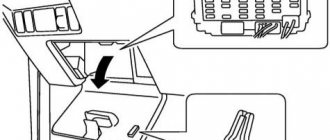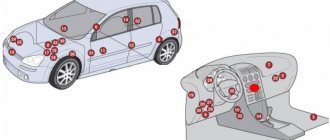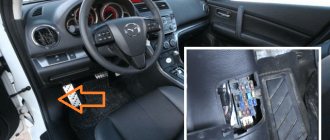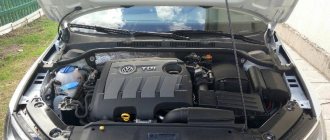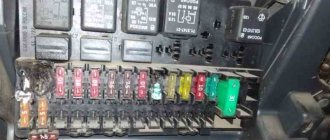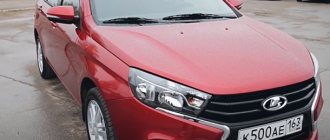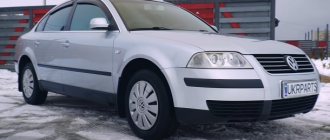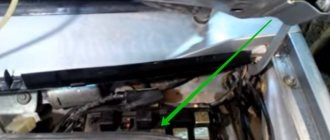Volkswagen Polo Sedan
— produced in Russia in 2010, 2011, 2012, 2013, 2014.
In 2015, the car was restyled and the updated model was also produced in 2016, 2022, 2022, 2022, 2022 and to the present. In our material we will show a description of fuses and relays for the Volkswagen Polo Sedan with block diagrams and their photographs, as well as the places where they are located. Let's highlight the fuse responsible for the cigarette lighter.
The purpose of the fuses in the blocks may differ from the material presented, and depends on the year of manufacture and equipment level (trendline, comfortline, etc.) of your car. In case of difficulty, contact your nearest dealer.
Blocks in the cabin
Fuse box
It is located under the steering column, behind the protective cover.
Scheme
General description of fuses
| 1 | Reserve |
| 2 | 10/15A Steering column switches, windshield washer pump, rear window wiper motor |
| 3 | 5/7.5A Fuel pump relay, engine control unit |
| 4 | 7.5A Steering column switches |
| 5 | Reserve |
| 6 | 5A Instrument cluster control unit |
| 7 | 5/15A Headlight beam direction control, license plate lights |
| 8 | 10A Injectors or reserve |
| 9 | 5/7.5A ABS control unit, ASR/ESP switch |
| 10 | 5/7.5A Head unit, Vehicle speed sensor, automatic transmission selector, power accessories control unit, ignition switch |
| 11 | 5A Headlight beam direction regulator, gear motors in headlights |
| 12 | 5A Joystick for adjusting rear view mirrors |
| 13 | 15A Automatic transmission control unit, automatic transmission multifunction switch, automatic transmission selector |
| 14 | 5/10A Airbag control unit |
| 15 | 5A Heating elements for windshield washer jets |
| 16 | 5/10A Parking sensor control unit |
| 17 | 10/15A Warming up the lambda probes and the clan of the fuel vapor recovery system |
| 18 | 5/7.5A Instrument cluster control unit, fog lamp in the left rear light |
| 19 | 5/7.5A Parking light relay, head audio unit, electrical package control unit, ignition and starter switch |
| 20 | 5/10A Instrument cluster control unit, steering column switches |
| 21 | 10/15A Electrical package control unit, directional lamps, interior lamp with switch-off delay, trunk lamp |
| 22 | 5/10A Diagnostic connector, air conditioning control unit, climate control unit, key lock solenoid in ignition switch |
| 23 | 7.5/10A Electrical package control unit, engine control unit, automatic transmission control unit, automatic transmission switch (manual mode) |
| 24 | 5A Electrical package control unit, heated exterior mirrors |
| 25 | 5/7.5A Refrigerant pressure sensor, air conditioning compressor relay, cooling fan control unit, air conditioning control unit, diagnostic connector, heating and ventilation control unit, diagnostic connector |
| 26 | 7.5/10A Power steering control unit |
| 27 | 5/15A Reversing lamp switch in the right rear lamp |
| 28 | 10A Lambda probe |
| 29 | 20A Ignition coils |
| 30 | 15A Canister solenoid valve, coolant pump, EGR radiator switching valve |
| 31 | 10A Cylinder Injectors |
| 32 | 10A Fuel pump, 30A Engine control unit |
| 33 | 5A Clutch pedal position sensor, brake light switch 10A Radiator fan control unit |
| 34 | 7.5A Right block - headlight (high beam) 20A High beam |
| 35 | 10A Engine control unit |
| 36 | 10/15A Fuel pump or injectors 20A Fuel supply relay via pressure line |
| 37 | 25A Driver seat heating regulator, front passenger seat heating regulator, front seat heating control unit |
| 38 | 7.5A Left block - headlight (high beam), instrument cluster control unit 30A Automatic transmission control unit |
| 39 | 10/15A Right block headlight (low beam) |
| 40 | 30A Heater fan switch, heater fan control unit |
| 41 | 15A Rear window wiper motor |
| 42 | 15/20A Cigarette Lighter Fuse |
| 43 | 15/20A Electrical accessories control unit, turn signal lamps, brake signal lamps |
| 44 | 15A Ultrasonic Security Alarm Sensor, Security Alarm Siren |
| 45 | 15/30A Navigation system control unit, audio head unit, multimedia system control unit |
| 46 | 20/30A Electrical package control unit (sound signal) |
| 47 | 20/30A Electrical package control unit (wiper motor) |
| 48 | 25A/30A Central locking, Luggage compartment door lock drive, Electric fuel filler flap |
| 49 | 5/15A Reversing lamp |
| 50 | 25/30A Driver's door control unit |
| 51 | 25/30A Front passenger door control unit |
| 52 | 30A Left rear door control unit, right rear door control unit |
| 53 | 30A Heated rear window |
| 54 | 15A Fog lights |
| 55 | 15A Ignition coils |
| 56 | 40A Heated windshield relay |
| 57 | 5/7.5A Side light bulbs in the left headlight and left rear light |
| 58 | 5/7.5A Side light bulbs in the right headlight and right rear light |
| 59 | 10/15A Left block - headlight (low beam) |
| 60 | 15A DRL |
Fuse number 42 for 15 or 20A is responsible for the cigarette lighter.
Designation in table form
Relay block
Most power supply circuits for vehicle electrical equipment are protected by fuses. Powerful current consumers are connected via relays. The main relay box is located under the instrument panel on the left side (driver's side).
Scheme
Decoding
- R1 - reserve;
- R2 – windshield heating relay (depending on configuration);
- R3 – starter blocking relay;
- R4 – fuel supply relay via pressure line;
- R5 – power supply relay;
- R6 - reserve;
- R7 – front side lights relay;
- R8 – fuel pump relay;
- R9 – air conditioning relay;
- R10 – contact relay “X”;
- R11 - R15 - reserve.
Fuse Box Diagrams
Dashboard
On a right-hand drive car, this panel is mirrored.
Assignment of fuses in the instrument panel
ampere part
| F1 | 5A | Instrument panel control unit ABS control unit Mobile phone control electronics control unit |
| F2 | 10A | Steering column combination switch On-board power supply Cleaner engine rear window Windshield and rear window washer pump |
| F3 | 5A | Fuel pump relay Engine control unit relay deposit fuel lock fuel pump control unit body sound control unit |
| F4 | 2A | (2A) Combination switch |
| F5 | – | – |
| F6 | 5A | Device control module |
| F7 | 5A | Headlight range control Left headlight license plate Right headlight license plate On-board power supply |
| F8 | 10A | Engine management system |
| F9 | 5A / 7.5A | TCS and ESP button Tire pressure monitor display sensor Steering angle ABS control unit System stop/start button Data bus diagnostic interface |
| F10 | 5A | Cruise control switch Steering column combination switch Brake light switch Clutch pedal On-board power supply |
| F11 | 5A/10A | Angle adjustment headlight leveling motor for headlight leveling, left headlight leveling motor for headlight leveling right headlight Cruise control switch On-board power supply control unit Turning light and headlight bezel control unit |
| F12 | 5A | Rearview mirror adjustment switch |
| F13 | 5A | Transmission Control Module (TCM) |
| F14 | 5A | Supplemental Restraint System (SRS) control unit |
| F15 | 5A | Hydraulic nozzles with heated windshield |
| F16 | 5A | Parking assistance control module |
| F17 | – | – |
| F18 | 5A | Rear fog lamp contact switch Control unit in the instrument panel Rear left fog lamp lamp On-board power supply |
| F19 | 5A | Multifunctional control module |
| F20 | 5A | Steering wheel angle sensor Control unit in instrument panel Fuel supply relay Fuel supply relay terminal 30 relay Low thermal power relay high voltage |
| F21 | 10A | Multifunctional control module |
| F22 | 5A | Diagnostic connector of the control unit control unit air conditioning control unit air conditioning control unit mobile phone control electronics Ignition key removal lock solenoid |
| F23 | 5A | Selector lever Rain sensor Onboard power supply control unit Engine control unit Data bus diagnostic interface |
| F24 | 5A | On-board power supply Heated outside mirror, driver's side Heated outside mirror, front passenger |
| F25 | 5A | High pressure sensor Heater control unit Radiator fan control unit Air conditioning control unit trailer detector check Diagnostic connector Humidity sensor Radiator fan control unit Stabilizer voltage stabilizer 2 |
| F26 | 7.5 A | Mass air flow meter oil level and temperature sensor steering control unit crankcase ventilation heating element Starter relay 1 Starter relay 2 |
| F27 | 7.5 A | Reversing lights |
| F28 | 10A | Engine management system |
| F29 | 10A | Engine management system |
| F30 | 10A | Engine management system |
| F31 | 5A/10A | Engine management system |
| F32 | 10A / 15A / 20A / 30A | Engine management system |
| F33 | 5A | Clutch position sensor Brake light switch |
| F34 | 15A | Control unit in the instrument panel left high beam lamps right high beam power control unit on board left exhaust lamp control unit unloading devices right gas dimming |
| F35 | 15A/20A | Engine management system |
| F36 | 7.5 A | Right high beam |
| F37 | 25A | Seat heating control unit |
| F38 | 30A | Transmission Control Module (TCM) |
| F39 | 10A / 15A | Right low beam |
| F40 | 30A | Air conditioner/heating fan control module |
| F41 | 10A | Rear window wiper motor |
| F42 | 15A | Cigarette lighter socket 12V |
| F43 | 15A | Multifunctional control module |
| F44 | 5A | Notification system |
| F45 | 15A | Audio system |
| F46 | 20A | Headlight washers |
| F47 | 20A | On-board power supply Wiper motor |
| F48 | 25A | Multifunctional control module |
| F49 | 15A/30A | Fuel pump relay Fuel relay |
| F50 | 25A | Driver door function control unit |
| F51 | 25A | Passenger door function control unit |
| F52 | 30A | Rear left door control unit Rear right door control unit |
| F53 | 30A | Multifunctional control module |
| F54 | 15A | Front fog lights |
| F55 | 15A/20A | Engine management system |
| F56 | 15A | Daytime Running Lights |
| F57 | 15A | Multifunctional control module |
| F58 | 20A | Brake booster vacuum pump |
| F59 | 10A / 15A | Left low beam |
| F60 | 15A | Audio system |
Main fuse box
Assignment of fuses in the main fuse block
ampere part
| SA1 | 150A/175A | generator |
| SA2 | 30A | Gas fuel control module |
| SA3 | 110A | |
| SA4 | 50A | Power steering control module |
| SA5 | 40A | ABS control module |
| SA6 | 40A | Coolant Fan Motor Control Module |
| SA7 | 50A | Glow plugs |
| SC1 | 25A | ABS control module |
| SC2 | 30A | Coolant Fan Motor Control Module |
| SC3 | 5A | Coolant Fan Motor Control Module |
| SC4 | 10A | ABS control module |
| PC5 | 5A | Multifunctional control module |
| SC6 | 30A | Transmission Control Module (TCM) |
Block under the hood
The fuse and fuse link mounting block is mounted on a plastic holder above the battery in the engine compartment.
Scheme
Description
| 1 | 25A ABS control unit |
| 2 | 30A Cooling fan motor control unit, cooling fan motor |
| 3 | 5A Cooling fan motor control unit |
| 4 | 10A ABS control unit |
| 5 | 5A Electrical package control unit |
| 6 | Reserve |
| SA1 | 150/175A Generator |
| SA2 | Reserve |
| SA3 | 110A Ignition switch, lighting switch, steering column switches, ignition switch contact relief relay, fuel pump relay, fuel supply relay when opening the driver's door, low beam headlight relay, fuse circuits 4, 20, 56, parking lights relay, power supply relay terminal 30 |
| SA4 | 50A Power steering control unit |
| SA5 | 40A ABS control unit |
| SA6 | 40A Cooling fan control unit |
| SA7 | Reserve |
Volkswagen Polo interior unit relay
All relays in the car are located on a separate mounting block, which is located in the dashboard on the left side of the driver.
- R4 - pressure gasoline supply relay.
- R3 - starter blocking relay.
- R9 - air conditioning relay.
- R7 - relay for headlights. See fuses 57 and 58.
- R8 - fuel pump relay.
- R5 - power relay.
- R6 - spare seat.
- R10 - relay contact “X”.
- R1 - reserve seat.
- R11 - R15 are reserved.
- R2 - windshield heating relay. See fuse 56.
Fuse blocks "A" and "C"
The fuse circuit is quite simple. Block A and block C are located on the Volkswagen Polo battery. Who did you miss? That's right, block B. It was hidden under the steering column in the car. In addition, inside the instrument panel on the left side there is a relay unit, an additional support for other control participants.
Has the generator stopped working or has the cooling fan stopped working on the Polo sedan? Then we go up to block A. It is in it that the fuses are located that are responsible for both parts of the car.
To access the mounting block, you need to press the lid latch and remove the “cap”. Under the cover we will find 7 fuses. First of all, the generator passes current through itself. Its power ranges from 150-175A. Next comes the ignition switch, steering column switches and various relays (low beam, fuel pump, etc.). The rated current of the fuse is 110A. Next comes the electric power steering control unit (50A), ABS and cooling system fan (40A each). Two places reserved.
Help with voltage redistribution is provided by block C. To access it, you need to disconnect the plastic clips on the sides in the engine compartment and remove the cover. 6 more fuses will burn out in front of us. Their circuit to some extent repeats that installed in block A.
Up to two slots: the first and fourth slots are responsible for the aforementioned ABS control section (25 and 10A respectively). The second and third slots control the cooling fan motor. The fifth is aimed at the correct operation of the electrical control unit. The last connector is a spare one.
Sources
- https://vmiredorog.com/tehpomosch/189-predohraniteli-i-rele-v-volkswagen-polo-sedan/
- https://moto-sol.ru/diagnostika-i-remont/folksvagen-polo-gde-predohraniteli.html
- https://AvtoMonitor.ru/predohraniteli-vw-polo-5.html
- https://avtoblokrele.com/blok-predohranitelej-i-rele-volkswagen-polo-sedan/
- https://rent-cabriolet.ru/remont/folksvagen-polo-gde-nahodyatsya-predohraniteli.html
- https://shassik.ru/transmissiya/predohraniteli-polo-sedan.html
- https://fuse-box.ru/predohraniteli-i-rele-volkswagen-polo-6r-mk5-2009-2017/
- https://venteler.ru/fol-ksvagen-polo-predokhranitel-konditsionera-gde-nakhoditsya-sedan/
- https://knigaproavto.ru/shemy/volkswagen/polo/366-perechen-predohraniteley-volkswagen-polo-s-2010.html
- https://zilart-auto.ru/remont/gde-nahodyatsya-predohraniteli-na-folksvagen-polo-sedan.html
Relay Polo
A standard 2001 and later Volkswagen has multiple relays. Parts are needed to safely turn on high-power equipment. The low side is connected to the control elements, the high voltage side cuts into the power line.
Air conditioning system
The switch for the R9 air conditioning system completely powers the entire device and is located in the interior mounting block installed at the end of the dashboard.
Main relay
The part is located on the bulkhead between the engine compartment and the car interior.
Switch position relay
When SA3 is turned on, the ignition switch is unloaded. The part is necessary for stable starting.
Relay regulator
The specified element is shown using the example of a Valeo generator. In the Bosch modification, the part looks different. The function and purpose of the devices is the same.
Helpful information
There are a few things you need to know about fuses:
- the machine should always have suitable fuses of each type in reserve;
- Repairing this part is strictly prohibited;
- installing an unsuitable or repairable fuse can cause a fire, electrical failure or an accident;
- You cannot install fuses designed for a higher current supply than the factory part.
To protect yourself, it is important to remember that you cannot replace a removed fuse with any available parts, even for a short period of time.
Block "B" and instrument panel relay block
The larger fuse box B is located inside the vehicle. It is located under the steering column. Access is not difficult. Just lower the lid and the sesame will open. For ease of working with devices, small tweezers are built into the socket of the mounting block of the Volkswagen Polo sedan.
The layout looks a little more confusing than previous configurations. Therefore, if you have to replace “plugs” in a block, it is better to have a drawing on hand with a detailed designation of each element.
It’s immediately worth noting the fuses that “go” to reserve: 1.5.28−31.41.60. In addition, slots can be “reserved”: 8 and 32. “Otto” can be used to protect engine injectors and connector “32” for the fuel pump.
Lighting devices include a group of devices that consume large amounts of energy:
- contact “21 °” is responsible for the interior lighting and luggage compartment (10A).
- The reversing light switch in the right lamp is switched off thanks to slot 27 (5A).
- "Fog" - 54 (15A).
- Brake lights and direction indicators - 43 (15A).
- The dimensions of the left headlight and left rear light are 57 (5A).
- Right headlight: high beam - 34 (7.5 A), low beam - 39 (10 A).
- Rear fog lamp - socket 18 (5A).
- Left headlight: high beam - 38 (7.5 A), low beam - 59 (10 A).
- The direction of the headlight beams is determined by special regulators. Two fuses are used for them: the “seventh” (also checks the glow of the numbers) and the “eleventh” (starts the gearmotors in the headlights). Both elements have a current strength of 5A.
- The dimensions of the right headlight and right rear light are 58 (5A).
Several fuses control the engine and drive at the same time: 3 (5 A), 13 (15 A) and 23 (7.5 A). The electrical circuit of the control unit includes fuses that control various vehicle functions. This group may include:
- Side light relay and main sound reproduction unit 19 (5A).
- Heated rear view mirrors - 24 (5A).
- Central locking and fuel filler neck - 48 (25A).
- Windshield washer motor - 47 (20A).
- Heated rear window - 53 (30A).
- Heated seats - 37 (25A).
- Automatic transmission and speed switch - 13 (15A).
- Sound signal - 46 (20A).
- Speed sensor, ignition switch and automatic selector - slot 10 (5A).
- Heated windshield - 56 (40A).
A large group consists of “plugs” that protect the heating and air conditioning system: 22 (5A), 25 (5A) and 40 (30A). The steering column switches include the following fuses: 2 (10A), 4 (2A), 20 (5A).
In total, the “plug” of the interior circuit has 60 connectors. It is difficult to remember the location of each element, so it is recommended to check the position of the fuses before replacing a damaged link.
An important condition when replacing contacts is the current strength, which must be observed during the procedure. In other words, a jumper designed for a different current cannot be inserted into the connector. It is also strictly forbidden to use the fruits of “handicraft” developments. The “homemade products” themselves will burn out, and some of the electronic equipment of the Polo sedan will also be “taken” with them. And in the worst case, a fire that could leave the owner of a German car with nothing.
Finally, the last part of the car's wiring is the relay, located on the side of the dashboard. To remove it from the panel, you need to lift the side cover with a flat-head screwdriver and remove it. Rock the device from side to side and carefully pull it out of the hole.
The relay has 15 contacts. The last five in the chain are not used. The rest is responsible for the operation of the starter, lobovukha heater, fuel pump, low beam headlights, air conditioning compressor, and so on. If the source of the problem is in this box, we find the broken contact and change the necessary relay on it.
Thus, two conclusions can be drawn. Firstly, if one of the car components fails, you should first inspect the fuse and relay blocks - perhaps the cause of the malfunction lies in their visibility range. This will save money spent on the services of specialists at the gas station. Secondly, replacing burnt out elements will not cause problems even for a novice polo expert. It is only important to have a traffic jam diagram at hand.
Removal and replacement process
To replace, you will need a multimeter, a slotted screwdriver and a 10 mm wrench.
Under the hood
To replace the fuse in block C, simply remove the cover from it, unfasten the plastic latches and pull out the blown element with your fingers. For block A the procedure is more complicated:
- Press the latch and open the MB cover.
- Check the condition of the fuses:
- Switch the multimeter to ohmmeter mode.
- Apply one probe to each terminal in turn, and the second to the L-shaped metal plate. If the device shows 1 or infinity, this means that the fuse link connected to the terminal has burned out.
- Unscrew the 5 nuts securing the terminals and disconnect them.
- Unscrew the nut on the C block side and press the plastic lock on the battery side.
- Remove the power fuse block.
- Install the removed elements in reverse order.
Video “Replacing fuses on Polo”
The author ALEKS Black is replacing the inserts on the previous generation Polo hatchback. Replacing fuses on the Polo Sedan follows an identical pattern.
Do you have any questions? Specialists and readers of the AUTODVIG website will help you ask a question
Was this article helpful?
Thank you for your opinion!
The article was useful. Please share the information with your friends.
Yes (80.00%)
No (20.00%)
X
Please write what is wrong and leave recommendations on the article
Cancel reply
Rate this article: ( 5 votes, average: 4.80 out of 5)
Discuss the article:
Location
In a 2012 car, the required element is located at number 42 and has a rating of 15 A. In other modifications, the fuse can be installed in a different location.
The photo above shows where the fuse is located in the most popular modification common in the CIS.
Connection diagram
Fundamentally, the connection diagram of the device is no different in the sedan, hatchback or station wagon version. Below is the electrical part and the complete connection cycle of all components of the cigarette lighter power circuit.
For ease of perception, the highway is highlighted in blue.
How to change a part
Such maintenance is not difficult; you can replace the part yourself. For car enthusiasts who do not want to waste time on such work, it is recommended to contact a service station.
With your own hands
As an example, we’ll tell you about replacing a “popular” cigarette lighter fuse on a Volkswagen Polo sedan with your own hands. This operation must be carried out with the ignition off.
To work, you need a service book for a car with a fuse diagram for a Volkswagen Polo. In the absence of such a document, information about its location should be found on the Internet.
Replacement is carried out as follows:
- We are studying information about where the cigarette lighter fuse is located in the Volkswagen Polo.
- The protective cover made of polymer material is removed.
- The required insert is removed using tweezers and checked for suitability with a multimeter.
- If a part malfunctions, a new fuse with the same value is installed.
Read also About bumpers on Volkswagen Polo
The lid is closed and the operation of the device is checked.
We disassemble the stove
I didn’t disassemble the engine, I just pulled it out of the housing and lubricated it, and for this you need:
1. Press on the rubber motor mounts, in the photo the heater motor has already been removed, the arrows show where to press in order to separate the heater motor from the engine.
2. Unhook the connector from the case itself, there is a little trick here, you also need to use an awl to remove the latches from engagement with the case. In the photo the connector is already pulled out.
And here he stood, i.e. insert the awl on this side.
After the engine and impeller were removed from the housing, cleaned and washed, I began to lubricate. It is better not to lubricate with motor oils and other solid oils, because it will be even worse, dirt and dust will stick, WD is also not recommended, mostly craftsmen use penetrating lubricants, which contain silicone and an evaporating solvent, for penetrating action. In general, I bought Akfix A40A40 Magic Aerosol from Leroy Merlin
Checking the health of fuses
If any vehicle device fails, it is necessary, using Tables 1 and 2, to determine which fuses are served by this element. Then you need to turn off the ignition.
In some cases (failure of the engine control unit, generator, side lights, cigarette lighter, etc.), it is better to remove the negative terminal of the battery. Then, using special dielectric pliers (you can use pliers), you need to disassemble the necessary fuses.
Testing fuses without removing them from the block may give an erroneous result.
Fuses in transparent housings can be checked visually. It should be remembered that this method of fault monitoring does not have a 100% guarantee, since sometimes it is not possible to see a microcrack in the conductive insert.
It is best to use the multimeter in the "diode", "resistance" or "continuity" test positions. The resistance value of a good fuse is approximately zero. The resistance of a blown fuse tends to infinity (the multimeter displays “1”).
Cigarette lighter repair
The standard device is a collapsible module - in fact, it can be repaired if a malfunction is detected. On a VW Polo, the unit does not need to be repaired. The parts are sold assembled and are cheap.
Usually the entire part is removed from the car and replaced with a known good one.
Causes of cigarette lighter failure
Among the common occurrences, factors stand out.
- Use of the device for purposes other than its intended purpose. Individual drivers often use the device as a charger or power source for powerful consumers. The device cannot withstand the load and fails.
- Short circuit in the network. Water ingress, damage to wiring and loosening of contacts provoke short circuits and failure of the unit.
- Careless use of the device. Each unit must be operated carefully. Over time, the fasteners and body of the device may become deformed.
How to remove and disassemble the cigarette lighter
The principle of the procedure is the same for cars 2011-2016. The bottom line is that the design of the part is quite primitive and does not require modification.
To disassemble the cigarette lighter you will need to follow a sequence of steps.
- Disconnect the car.
- Using a special tool or a “homemade device”, press out the core fastening terminals.
- After this, remove the cigarette lighter from the plastic socket.
- Next, you will need to disconnect the terminal of the contact group and dismantle the device.
- The next step is to remove the plastic casing of the device. To do this, you need to take an awl or a thin screwdriver and pry off the expansion clamps.
- After this, the socket can be removed and the contacts from the backlight bulb disconnected.
Troubleshooting the food chain
On 2022 cars, some users encountered problems with the cigarette lighter line. Similarly, faults can appear in older cars.
To find and eliminate the malfunction, the entire circuit must be completely checked. The procedure begins with diagnosing the fuse. Next, the power line and the cigarette lighter itself are diagnosed.
Changing the backlight bulb
In rare cases, the light on the cigarette lighter burns out. To replace the illuminator lamp, you will need to dismantle the device and disassemble its housing. A standard lamp of a fairly common standard size is used inside.
